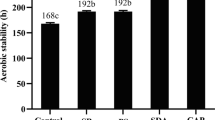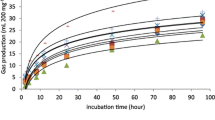Abstract
Whole crop rice was harvested 120 days after planting and chopped to 2–3-cm length for silage making. The whole crop rice silage (WCRS) was supplemented with different levels of molasses and urea to study nutritive value and in situ rumen degradability. The ensiling study was randomly assigned according to a 6 × 5 factorial arrangement, in which the first factor was molasses (M) supplementation at M0, M1, M2, M3, M4, and M5 %, and the second was urea (U) supplementation at U0, U0.5, U1.0, U1.5, and U2.0 % of the crop dry mater (DM), respectively. After 45 days of ensiling, temperature, pH, chemical composition, and fermentation end products of the silages were measured. Ten U and M treatment combinations of WCRS were subsequently selected to study rumen degradability by nylon bag technique. The results showed that temperature and pH of the silages linearly increased with U supplementation level, while total volatile fatty acid (TVFA), acetic acid (C2) and propionic acid (C3) decreased. In contrast, increasing level of M supplementation decreased WCRS temperature and pH, whereas TVFA, C2, and C3 concentrations increased dramatically. Both M and U supplementation increased concentration of butyric acid (C4). Dry matter, organic matter (OM), and acid detergent fiber (ADF) contents of the silages were not influenced by either M or U supplementation. Increasing U supplementation increased crude protein (CP) content, while M level did not show any effect. Furthermore, neutral detergent fiber (NDF) content in silage was decreased by both M and U supplementation. The results of the in situ study showed that M and U supplementation increased both ruminal DM and OM degradation. The water-soluble fraction (a) was the highest in WCRS U1.5M3 and lowest in U0M0. Increasing M and U supplementation levels increased the potentially degradable fraction (b) of both DM and OM. Total rumen degradable fraction (a + b) was highest in WCRS U1.5M3, whereas OM degradability was highest in U0M3. However, effective degradation of both DM and OM were the highest in WCRS U1.5M3 and the lowest in U0M0. We conclude that supplementation of U and M increases WCRS quality and rumen degradability. Supplementation of U at 1.5 and M at 3–4 % of the crop DM is recommended for lactating dairy cows and fattening beef cattle.
Similar content being viewed by others
Abbreviations
- WCRS:
-
Whole crop rice silage
- DM:
-
Dry matter
- M:
-
Molasses
- U:
-
Urea
- CP:
-
Crude protein
- ADF:
-
Acid detergent fiber
- NDF:
-
Neutral detergent fiber
- OM:
-
Organic matter
- TVFA:
-
Total volatile fatty acid
- C2:
-
Acetic acid
- C3:
-
Propionic acid
- C4:
-
Butyric acid
References
AFRC, 1993. Energy and protein requirements of ruminants. An advisory manual prepared by the AFRC Technical Committee on Responses to Nutrients. Compiled by G. Alderman, in collaboration with B.R. Cottrill. CAB International, Wallingford, UK.
Ajila, C.M., Brar, S.K., Verma, M., Tyagi, D.R., Godbout, S. and Valéro, J.R., 2012. Bio-processing of agro-byproducts to animal feed. Critical Review Biotechnology, 32 (4), 382–400.
Alli, I., Fairbairn, R., Noroozi, E. and Baker, B.E., 1984. The effects of molasses on the fermentation of chopped whole plant leucaena. Journal of the Science of Food and Agriculture, 35(3), 285–289.
AOAC 1990. Official methods of analysis. Association of Official Analysis Chemists, DC, U.S.A.
Bartzanas, T., Bochtis, D.D., Green, O., Sørensen, C.G. and Fidaros D., 2013. Prediction of quality parameters for biomass silage: A CFD approach. Computers and Electronics in Agriculture, 93, 209–216
Cao, Y., Takahashi, T. and Horiguchi, K., 2009. Effects of addition of food by products on the fermentation quality of a total mixed ration with whole crop rice and its digestibility, preference, and rumen fermentation in sheep. Animal Feed Science and Technology, 151, 1–11.
Cheli, F., Campagnoli, A. and Dell’Orto, V., 2013. Fungal populations and mycotoxins in silages: From occurrence to analysis. Animal Feed Science and Technology, doi:10.1016/j.anifeedsci.2013.01.013.
Chen, X.B., 1996. An excel application program for processing feed degradability data. Rowett Research Institute, Bucksburn, Aberdeen, UK.
Dunièrea, L., Sindou, J., Chaucheyras-Durand, F., Chevallier, I., Thévenot-Sergentet, D., 2013. Silage processing and strategies to prevent persistence of undesirable microorganisms. Animal Feed Science and Technology, 182, 1–15.
Granzin, B.C. and Dryden, G.M., 2005. Monensin supplementation of lactating cows fed tropical grasses and cane molasses or grain. Animal Feed Science and Technology, 120(1–2), 1–16.
Khan, M.A., Sarwar, M., Nisa, M., Iqbal, Z., Khan, M.S., Lee, W.S., Lee, H.J. and Kim, H.S., 2006. Chemical composition, in situ digestion kinetics and feeding value of Oat grass (Avena sativa) ensiled with molasses for Nili-Ravi buffaloes. Asian-Australasian Journal of Animal Science, 19, 1127–1133.
Ki, K.S., Khan, M.A., Lee, W.S., Lee, H.J., Kim, S.B., Yang, S.H., Baek, K.S., Kim, J.G. and Kim, H.S., 2009. Effect of replacing corn silage with whole crop rice silage in total mixed ration on intake, milk yield and its composition in Holsteins. Asian-Australasian Journal of Animal Science, 22(4), 516–519.
Mohd-Setapar, S.H., Abd-Talib, N. and Aziz R., 2012. Review on crucial parameters of silage quality. APCBEE Procedia, 3, 99–103.
Orskov, E.R. and McDonald, I., 1979. The estimation of protein degradability in the rumen for incubation measurements weighted according to rate of passage. Journal of Agricultural Science (G.B.), 92, 499–503.
Sahoo, B. and Walli, T.K., 2008. Effects of formaldehyde treated mustard cake and molasses supplementation on nutrient utilization, microbial protein supply and feed efficiency in growing kids. Animal Feed Science and Technology, 142(3–4), 220–230.
Samuel, M., Sagathewan, S., Thomas, J. and Mathen, G., 1997. An HPLC method for estimation of volatile fatty acids of ruminal fluid. Indian Journal of Animal Science, 67, 805.
Santoso, B., Hariadi, B.T., Manik, H. and Abubakar, H., 2011. Silage quality of king grass (Pennisetum purpureophoides) treated with epiphytic lactic acid bacteria and tannin of acacia. Media Peternakan, 30(2), 140–145.
SAS, 1998. User's Guide: Statistic, Version 6, 12th Edition. SAS Inst. Inc, Cary, NC.
Seppälä, A., Heikkiläa, T., Mäkia, M., Miettinenb, H. and Rinne, M., 2013. Controlling aerobic stability of grass silage-based total mixed rations. Animal Feed Science and Technology, 179, 54–60.
Shellito, S.M., Ward, M.A., Lardy, G.P., Bauer, M.L. and Caton, J.S., 2006. Effects of concentrated separator by-product (desugared molasses) on intake, ruminal fermentation, digestion, and microbial efficiency in beef steers fed grass hay. Journal of Animal Science, 84(6), 1535–1543.
Steel, R.G.D. and Torrie, J.H., 1980. Principles and procedure of statistics. New York: McGraw Hill Book Co.
Touqir, N.A., Khan, M.A., Sarwar, M., Nisa, M., Ali, C.S., Lee, W.S., Lee, H.J. and Kim, H.S., 2007a. Feeding value of Jambo grass silage and mott grass silage for lactating Nili buffaloes. Asian-Australasian Journal of Animal Science, 20, 523–528.
Touqir, N.A., Khan, M.A., Sarwar, M., Nisa, M., Lee, W.S., Lee, H.J. and Kim, H.S., 2007b. Influence of varying dry matter and molasses levels on berseem and lucerne silage characteristics and their in situ digestion Kinetics in Nili buffalo bulls. Asian-Australasian Journal of Animal Science, 20, 887–893.
Van Soest, P.J., Robertson, J.B. and Lewis, B.A., 1991. Methods for dietary fiber neutral detergent fiber and non-starch polysaccharides in relation to animal nutrition. Journal of Dairy Science, 74, 3583–3597.
Wang, Z.S. and Goetsch, A.L., 1998. Intake and digestion by Holstein steers consuming diets based on litter harvested after different numbers of broiler growing periods or with molasses addition before deep-stacking. Journal of Animal Science, 76(3), 880–887.
Weinberg, Z.G., Khanal, P., Yildiz, C., Chen, Y. and Arieli, A., 2010. Effects of stage of maturity at harvest, wilting and LAB inoculant on aerobic stability of wheat silages. Animal Feed Science and Technology, 158, 29–35.
Acknowledgment
The authors are grateful for the financial support, research collaboration, and facilitations of the Tropical Feed Resources Research and Development Center (TROFREC), Department of Animal Science, Faculty of Agriculture, Khon Kaen University.
Author information
Authors and Affiliations
Corresponding author
Rights and permissions
About this article
Cite this article
Wanapat, M., Kang, S., Khejornsart, P. et al. Improvement of whole crop rice silage nutritive value and rumen degradability by molasses and urea supplementation. Trop Anim Health Prod 45, 1777–1781 (2013). https://doi.org/10.1007/s11250-013-0433-0
Accepted:
Published:
Issue Date:
DOI: https://doi.org/10.1007/s11250-013-0433-0




